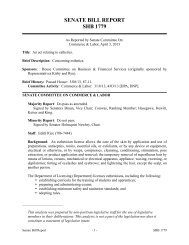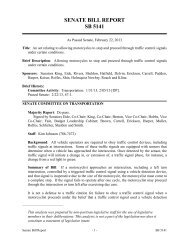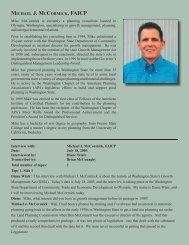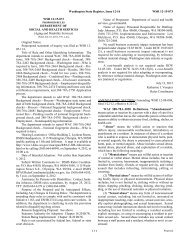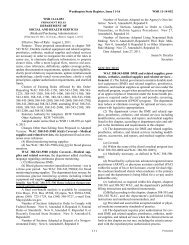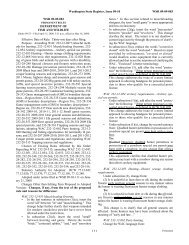Proposed
Proposed
Proposed
You also want an ePaper? Increase the reach of your titles
YUMPU automatically turns print PDFs into web optimized ePapers that Google loves.
WSR 12-21-103 Washington State Register, Issue 12-21<br />
(e) Limited energy system (06): Limited to the installation<br />
of signaling and power limited circuits and related<br />
equipment. This specialty is restricted to low-voltage circuits.<br />
This specialty includes the installation of telecommunications,<br />
HVAC/refrigeration low-voltage wiring, fire protection<br />
signaling systems, intrusion alarms, energy management<br />
and control systems, industrial and automation control systems,<br />
lighting control systems, commercial and residential<br />
amplified sound, public address systems, and such similar<br />
low-energy circuits and equipment in all occupancies and<br />
locations.<br />
(i) For the purposes of this section, when a line voltage<br />
connection is removed and reconnected to a replacement<br />
component located inside the control cabinet, the replacement<br />
must be like-in-kind or replaced using the equipment<br />
manufacturer's authorized replacement component. The line<br />
voltage circuit is limited to 120 volts 20 amps maximum and<br />
must have a means of disconnect.<br />
(ii) The limited energy systems (06) specialty may repair<br />
or replace line voltage connections terminated inside the cabinet<br />
to power supplies internal to the low voltage equipment<br />
provided there are no modifications to the characteristics of<br />
the branch circuit/feeder load being supplied by the circuit.<br />
(iii) The limited energy systems (06) specialty may not<br />
replace or modify the line voltage circuit or cabling or alter<br />
the means of connection of the line voltage circuit to the<br />
power supply or to the control cabinet.<br />
Limited energy electrical contractors may perform all<br />
telecommunications work under their specialty (06) electrical<br />
license and administrator's certificate.<br />
(f) HVAC/refrigeration systems:<br />
(i) See WAC 296-46B-100 for specific HVAC/refrigeration<br />
definitions.<br />
(ii) For the purposes of this section when a component is<br />
replaced, the replacement must be like-in-kind or made using<br />
the equipment manufacturer's authorized replacement component.<br />
(iii) The HVAC/refrigeration specialties described in<br />
(f)(v) and (vi) of this subsection may:<br />
(A) Install HVAC/refrigeration: Telecommunications,<br />
Class 2 low-voltage control circuit wiring/components in all<br />
residential occupancies;<br />
(B) Install, repair, replace, and maintain line voltage<br />
components within HVAC/refrigeration equipment. Such<br />
line voltage components include product illumination luminaires<br />
installed within and powered from the HVAC/refrigeration<br />
system (e.g., reach-in beverage coolers, frozen food<br />
cases, produce cases, etc.) and new or replaced factory authorized<br />
accessories such as internally mounted outlets;<br />
(C) Repair, replace, or maintain the internal components<br />
of the HVAC/refrigeration equipment disconnecting means<br />
or controller so long as the disconnecting means or controller<br />
is not located within a motor control center or panelboard<br />
(((see Figure 920-1 and Figure 920-2)));<br />
(D) Install, repair, replace, and maintain short sections of<br />
raceway to provide physical protection for low-voltage<br />
cables. For the purposes of this section a short section cannot<br />
mechanically interconnect two devices, junction boxes, or<br />
other equipment or components; and<br />
<strong>Proposed</strong> [ 68 ]<br />
(E) Repair, replace, or maintain line voltage flexible supply<br />
whips not over six feet in length, provided there are no<br />
modifications to the characteristics of the branch circuit/feeder<br />
load being supplied by the whip. There is no limitation<br />
on the whip raceway method (e.g., metallic replaced<br />
by nonmetallic).<br />
(iv) The HVAC/refrigeration specialties described in<br />
(f)(v) and (vi) of this subsection may not:<br />
(A) Install line voltage controllers or disconnect<br />
switches external to HVAC/refrigeration equipment;<br />
(B) Install, repair, replace, or maintain:<br />
• Integrated building control systems, other than<br />
HVAC/refrigeration systems;<br />
• Single stand-alone line voltage equipment or components<br />
(e.g., heat cable, wall heaters, radiant panel heaters,<br />
baseboard heaters, contactors, motor starters, and similar<br />
equipment) unless the equipment or component:<br />
Is exclusively controlled by the HVAC/refrigeration system<br />
and requires the additional external connection to a<br />
mechanical system(s) (e.g., connection to water piping, gas<br />
piping, refrigerant system, ducting for the HVAC/refrigeration<br />
system, gas fireplace flume, ventilating systems, etc.<br />
(i.e., as in the ducting connection to a bathroom fan)). The<br />
external connection of the equipment/component to the<br />
mechanical system must be required as an integral component<br />
allowing the operation of the HVAC/refrigeration system;<br />
or<br />
Contains a HVAC/refrigeration mechanical system(s)<br />
(e.g., water piping, gas piping, refrigerant system, etc.) within<br />
the equipment (e.g., "through-the-wall" air conditioning<br />
units, self-contained refrigeration equipment, etc.);<br />
• Luminaires that serve as a building or structure lighting<br />
source, even if mechanically connected to a HVAC/refrigeration<br />
system (e.g., troffer luminaire used as a return air<br />
device, lighting within a walk-in cooler/freezer used for personnel<br />
illumination);<br />
• Raceway/conduit systems;<br />
• Line voltage: Service, feeder, or branch circuit conductors.<br />
However, if a structure's feeder/branch circuit supplies<br />
HVAC/refrigeration equipment containing a supplementary<br />
overcurrent protection device(s), this specialty may install<br />
the conductors from the supplementary overcurrent device(s)<br />
to the supplemental HVAC/refrigeration equipment if the<br />
supplementary overcurrent device and the HVAC/refrigeration<br />
equipment being supplied are located within sight of<br />
each other (((see Figure 920-2))); or<br />
• Panelboards, switchboards, or motor control centers<br />
external to HVAC/refrigeration system.<br />
(v) HVAC/refrigeration (06A):<br />
(A) This specialty is not limited by voltage, phase, or<br />
amperage.<br />
(B) No unsupervised electrical trainee can install, repair,<br />
replace, or maintain any part of a HVAC/refrigeration system<br />
that contains any circuit rated over 600 volts whether the circuit<br />
is energized or deenergized.<br />
(C) This specialty may:<br />
• Install HVAC/refrigeration: Telecommunications,<br />
Class 2 low-voltage control circuit wiring/components in<br />
other than residential occupancies:<br />
That have no more than three stories on/above grade; or



